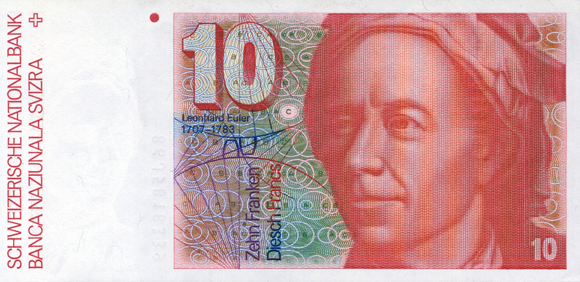fix at pleasure

In addition to his substantial contributions to science (see Bogolyubov, Mikhailov & Yushkevich 2007) the eminent swiss mathematician and physicist ↑Leonhard Euler (1707-1783) also wrote texts accessible to the general public. Eulers didactics are absolutely admirable because you can dive into both ‘Elements of Algebra’ (1770) and ‘Letters of Euler on different subjects in physics and philosophy addressed to a german princess’ (1768-1774) without presuppositions, without any previous knowledge whatsoever. His ‘Elements of Algebra’ begin at virtually nothing and then build up to unforeseen heights. Here is in full the beginning of chapter one of section one of part one, which simply is headed ‘Of mathematics in general:’
1. Whatever is capable of increase or diminution, is called magnitude, or quantity.
A sum of money therefore is a quantity, since we may increase it or diminish it. It is the same with a weight, and other things of this nature.
2. From this definition, it is evident that the different kinds of magnitude must be so various, as to render it difficult to enumerate them and this is the origin of the different branches of Mathematics, each being employed on a particular kind of magnitude. Mathematics, in general, is the science of quantity; or, the science which investigates the means of measuring quantity.
3. Now, we cannot measure or determine any quantity, except by considering some other quantity of the same kind as known, and point out their mutual relation. If it were proposed, for example, to determine the quantity of a sum of money, we should take some known piece of money, as a louis, a crown, a ducat, or some other coin, and show how many of these pieces are contained in a given sum. In the same manner, if it were proposed to determine the quantity of a weight, we should take a certain known weight; for example, a pound, and ounce, &c., and then show how many times one of these weights is contained in that which we are endeavouring to ascertain. If we wished to measure any length, or extension, we should make use of some known length, such as a foot.
4. So that the determination, or the measure of magnitude of all kinds, is reduced to this: fix at pleasure upon any one known magnitude of the same species with that which is to be determined, and consider it as the measure or unit; then, determine the proportion of the proposed magnitude to this known measure. This proportion is always expressed by numbers; so that a number is nothing but the proportion of one magnitude to another, arbitrarily assumed a unit.
5. From this it appears that all magnitudes may be expressed by numbers; and that the foundation of all the Mathematical Sciences must be laid in a complete treatise on the science of numbers, and in an accurate examination of the different possible methods of calculation. (Euler 1822 [1770]: 1-2 | bold emphasis mine)

Now compare this to what ↑Henri Poincaré wrote on ‘science and hypothesis’—for the full passage of the text see ↵poincaré on sts:
[…] the position held by hypothesis was seen ; it was recognised that it is as necessary to the experimenter as it is to the mathematician.
[…] we should examine with the utmost care the role of hypothesis ; we shall then recognise not only that it is necessary, but that in most cases it is legitimate. We shall also see that there are several kinds of hypotheses; that some are verifiable, and when once confirmed by experiment become truths of great fertility; that others may be useful to us in fixing our ideas; and finally, that others are hypotheses only in appearance, and reduce to definitions or to conventions in disguise. The latter are to be met with especially in mathematics , and in the sciences to which it is applied. From them, indeed, the sciences derive their rigour ; such conventions are the result of the unrestricted activity of the mind, which in this domain recognises no obstacle. For here the mind may affirms because it lays down its own laws ; but let us clearly understand that while these laws are imposed on our science, which otherwise could not exist, they are not imposed on Nature.
[…] the aim of science is not things themselves, as the dogmatists in their simplicity imagine, but the relations between things; outside those relations there is no reality knowable. (Poincaré 1905 [1902]: xxi-xxiv)
And for the sake of it, here is the German original of the above Euler-quote, ‘Von den mathematischen Wissenschaften überhaupt:’:
1.
Erstlich wird alles dasjenige eine Größe genennt, welches einer Vermehrung oder einer Verminderung fähig ist, oder wozu sich noch etwas hinzusetzen oder davon wegnehmen läßt.
Diesemnach ist eine Summa Gelds eine Größe, weil sich dazu setzen und hinweg nehmen läßt.
Ingleichen ist auch ein Gewicht eine Größe und dergleichen mehr.2.
Es giebt also sehr viel verschiedene Arten von Größen, welche sich nicht wohl herzehlen laßen; und daher entstehen die verschiedene Theile der Mathematic, deren eine jegliche mit einer besondern Art von Größen beschäftiget ist, indem die Mathematic überhaupt nichts anders ist als eine Wißenschaft der Größen, und welche Mittel ausfündig macht, wie man dieselben ausmeßen soll.3.
Es läßt sich aber eine Größe nicht anders bestimmen oder ausmeßen, als daß man eine Größe von eben derselben Art als bekannt annimt, und das Verhältniß anzeiget, worinnen eine jegliche Größe, von eben der Art, gegen derselben steht.
Also wann die Größe einer Summa Gelds bestimmt werden soll, so wird ein gewißes Stück Geld als z. E. ein Gulden, ein Rubel, ein Thaler, oder ein Ducaten und dergleichen für bekannt angenommen, und angezeigt wie viel dergleichen Stücke in gemeldeter Summa Gelds enthalten sind.
Eben so wann die Größe eines Gewichts bestirnt werden soll, so wird ein gewißes Gewicht als z. E. ein Pfund, ein Centner, oder ein Loth und dergleichen für bekannt angenommen, und angezeigt wie viel derselben in dem vorigen Gewicht enthalten sind.
Soll aber eine Länge oder eine Weite ausgemeßen werden, so pfleget man sich darzu einer gewißen bekannten Länge, welche ein Fuß genennet wird, zu bedienen.4.
Bey Bestimmungen, oder Ausmeßungen der Größen von allen Arten, kommt es also darauf an, daß erstlich eine gewiße bekannte Größe von gleicher Art fest gesetzet werde (welche das Maaß, oder die Einheit, genennet wird) und also von unserer Willkühr lediglich abhängt; hernach daß man bestimme in was für einem Verhältniß die vorgegebene Größe gegen dieses Maaß stehe, welches jederzeit durch Zahlen angezeigt wird, so daß eine Zahl nichts anders ist als das Verhältniß, worinnen eine Größe gegen eine andere, welche für die Einheit angenommen wird, steht.5.
Hieraus ist klar, daß sich alle Größen, durch Zahlen ausdrücken laßen, und also der Grund aller Mathematischen Wißenschaften darin gesetzt werden muß, daß man die Lehre von den Zahlen, und alle Rechnungs-Arten, so dabey vorkommen können, genau in Erwegung ziehe, und vollständig abhandele.

